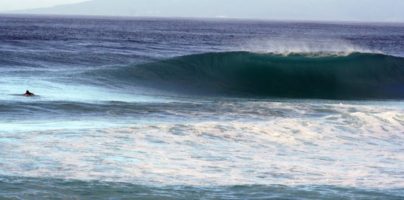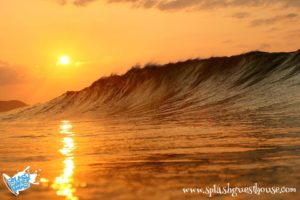There is tons of information on the internet about surfing in Japan. Unfortunately most of it is in Japanese and that makes planning a surf trip to Japan rather difficult for most people on this planet. Dane Gillett has lived and surfed in Japan for over 15 years and runs the English website surfinginjapan.com. He gave us an interview (read here) and the amount of information was overwhelming - so some frequently asked questions got outsourced to this article. The infos are not extensive or complete but they give you a rough overview about surfing in Japan.
What's the best time to surf in Japan?
If you want guaranteed waves the best season is from September till November. That is the typhoon season in Japan and during that time you will get swell. Serious swell - shoulder high to triple overhead
In the winter season from December to April there are some good waves as well but the water is very cold.
The most unfavorable months are May and June. This is the change of the seasons and the waves are quite fickle. However every now and then a storm brings a decent swell. You have to be there at the right time. (We have experienced this - we had to be patient and wait for the swell but totally worth it)
Where are the best surf spots in Japan?
There are countless surf spots but actually you could divide Japan in two main surf zones: the prefecture of Chiba and Miyazaki. These are the areas where there is great surf on a variety of spots. Especially Chiba is a swell magnet and very consistent. In fact, all in all it gets flat only a few weeks in the year. There are other equally consistent spots but Chiba is so popular because its so close to Tokyo.
Miyazaki, in the southwest of Japan also has a southeast-facing shore like Chiba and that is perfect to catch typhoon swell. Because its so far away from the major cities you can score some uncrowded waves. The wave pool at the Seagaia Ocean Dom unfortunately closed, it was the perfect solution for those flat days
There are other great areas. Explore the North of Japan like Sendai, Ibaraki. Fukushima has great waves but for obvious reasons you can't surf there anymore. Overall the surf in the North is really good but the water is very cold. The weather and swell patterns are different than in the south. During the winter in Sendai there are surfers in full dry suits, till summer you need a 5/3 and during summer a 3/2 wetsuit is enough.
Between Chiba and Miyazaki there is Kanagawa in the bay of Shonan. Most waves are generated by typhoon swell or during short window after a storm close to shore. Otherwise it can be pretty flat. The north winter swells are blocked by Chiba. The region got a huge surfing community because its a 40min train ride from Toyko. Many spots are reef and when it's on there can be some epic waves.
The Izu area is west of Kanagawa and is quit fickle. This region is blocked from most swells but can get good waves if there are big typhoon swells or the northeast swells roll in during the winter.
Another area is Shizouka, in the center of mainland Japan, there can be some great surf but its an open coastline and it can be a bit fickle. The swell is not very clean and can often close out or be messy. Due to the open coastline there are also many ocean defenses. The water is rather deep so there are few point breaks.
The tropical island of Okinawa is known for surfing. Its mostly reef break. The island is also rather fickle - either there is a lack of swell or too wind affected. The best time is when there are huge ground swells generated from the typhoons forming around the Philippines between August and October.
What kind of wetsuit do I need to bring?
- April to July a 3/2 full wetsuit
- August to September boardshorts, neoprene top or spring wetsuit
- Oktober to November a 3/2 full wetsuit
- December to March a 4/3 full wetsuit with booties sometimes hoodie
What kind of surfboard do I need in Japan? Can I rent a surfboard?
For serious waves bring what you like for serious waves but be prepared for some mushy waves. An allrounder surfboard is always a good call. Like this one or this one.
Surfboards can be rented everywhere in Japan. There are surfshops close to most well-known surfspots. The rates are similar in most places - 5'000 yen a day or 3'500 yen a half day.
Is it easy to travel with a surfboard in Japan?
Bring your own surfboard because travelling around Japan with a surfboard is very easy. There is an inexpensive door to door delivery service - instead of carrying your boards on buses, trains and planes you just ship it. In Japanese its called Takubin or Takuhaibin. This baggage shipping service is very common in Japan. If you arrive at the airport - just go straight to the counter of one of these companies and send your surfbag to your hotel, a pickup location or private address. If you want to resend it - either your hotel reception will do it for you, you can contact them and they will pick it up or go to any 7-11 convenience store and they can send it. Its so great - every country should have this. However you can't send surfboard back to the airport for some unknown reason. You can send your normale luggage but not surfboards.
All pictures are owned by Dane Gillett from www.surfinginjapan.com He gave us permission to use these. Respect the copyright.















